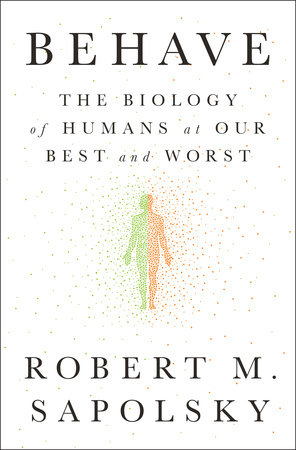by HENRY MARSH

You will learn more about human nature than in any other book I can think of.
Written on the monument to Kant in Kaliningrad (once Königsberg) are the final words of his Critique of Practical Reason. Only two things, he wrote, filled his mind with ever-increasing awe – the starry heavens above him and the moral law within him. In the equally awe-inspiring book Behave: The Biology of Humans at Our Best and Worst, Robert Sapolsky, a neurobiologist at Stanford, endocrinologist and expert on baboons, sets out to ground morality in neurobiology as opposed to the pure reason of Kant’s “categorical imperative”. But unlike Kant (at least for me), Sapolsky is highly readable. Behave is a tour de force of science writing for the general public – scholarly and all-encompassing, lucid, profound but light-hearted and with very funny footnotes and learned endnotes. You do not often read a book of almost 800 pages on such a serious subject with so much enjoyment.
Sapolsky presents his analysis in reverse-chronological order. The first chapters describe the immediate neurological processes in our brains that generate behaviour. He is concerned not with the (relatively) simple mechanisms of perception and movement but with the parts of the brain – in essence, the frontal and inner temporal lobes – where cognition (thinking) and feeling take place. The book goes backwards in time from the immediate action of the nerve cells that generated a behaviour to the hormonal, genetic and environmental influences that resulted in the brain cells firing in the way they did. So the book starts with hard neuroscience and moves through endocrinology and genetics to psychology, anthropology, history and evolutionary biology. Sapolsky deals with each of these with great clarity, always stressing the variability and complexity of the experimental results he describes. He writes that if his book has an underlying theme, it is: “It’s complicated.” He is a determinist but not a simple one.
Until only a few decades ago, the frontal lobes of the brain were seen as a black box. We knew that people with damage to the frontal lobes suffered personality change. We knew that a very high proportion of people in prison for violent offences had a history of head injury earlier in their lives. In the 19th century, doctors learned of Phineas Gage, the unfortunate Irish-American railway worker who, in 1848, had a tamping iron blasted through his skull in an explosion. Gage suffered a major personality change for the worse and was condemned to be mentioned in all popular neuroscience lectures and books ever since. You can see his skull at Harvard Medical School’s Warren Anatomical Museum.
New Statesman for more
